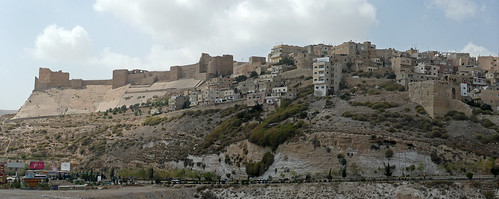Fortress of the Raven (Repost)

(Photo from Flickr user frankenschulz under a Creative Commons license)
Despite having spent a lot of time in Jordan, I've never been to Karak, the name of a town near the Dead Sea and its imposing castle which may be the kingdom's most visited Crusader site. Begun around 1142 by Pagan the Butler under the aegis of the Kingdom of Jerusalem, it may be most famous in the West as a seat of Reynald of Chatillon, whose reputation for provocation was illustrated in the 2005 film Kingdom of Heaven. Reynald's actions wrecked the truce which existed between Saladin and Baldwin IV (the Leper King), leading not only Jerusalem, but Karak to fall to Saladin and the Ayyubid dynasty he founded.
Last year saw the publication of The Fortress of the Raven, a typically expensive Brill title by Marcus Milwright, who has also written a historical account for the Virtual Karak Resources Project. The book combines evidence from both material and written sources to reconstruct the political and economic history of the Karak area in ways that highlight the relationship between them. His concluding paragraph begins, "Karak may be regarded as a market town whose history was transformed by the construction of a major castle at its southern extremity." The area did produce an agricultural surplus and benefited from traffic along the Kingshighway, but the construction of the fortress led to its becoming an administrative center with rulers and bureaucrats importing luxuries, primarily from Palestine, making it a more important trading stop than it would otherwise have been.
The castle's strategic importance is best illustrated by an account Milwright describes on pp. 38-9 of his book, in which following the capture of the Egyptian port Damietta by the Fifth Crusade, the status of Karak and the outpost of Shawbak further south were the chief sticking point in negotiations, as the Crusaders felt they could not permit Ayyubid bases so close to a reconstituted Kingdom of Jerusalem, nor were the Ayyubids willing to risk a possible division of Syria and Egypt through an undefended Jordan. A later Ayyubid ruler would advise his son to hand over both Shawbak and the coast of Syria before relinquishing Karak.
The age of Egypt's Mamluk rulers, however, which began in 1250, would make evident another reason for Karak's strategic importance. Sultan Baybars stayed in the castle regularly in order to maintain a relationship with the Bedouin of the area, who provided intelligence, livestock, and military services. Later, after the 1293 assassination of Sultan al-Ashraf Khalil, who had driven the Crusaders from their last outpost in Acre, the leaders of rival factions installed the 9-year-old an-Nasir Muhammad as a puppet, though after a shift in their schemes several months later he was sent into exile in Karak, an area he came to know well. In 1299 he was recalled again to serve as puppet, but after ten years taken up mainly with wars against the Mongols, he sought to escape the powers behind the throne and went back to Karak, where he tried to win allies among the area's magnates and Bedouin. After about a year he returned to Cairo with their support and began a 32-year reign which is usually considered the apogee of Mamluk power.
For whatever reason, the later Mamluks paid less attention to the area, and shortly after the Ottomans conquered the region in the early 1500's, they began ruling through the local Bedouin leaders while developing a new transportation route and fortresses further east, probably close to the Desert Highway of today.
Labels: Books, Christianity, History, Jordan


0 Comments:
Post a Comment
Subscribe to Post Comments [Atom]
<< Home